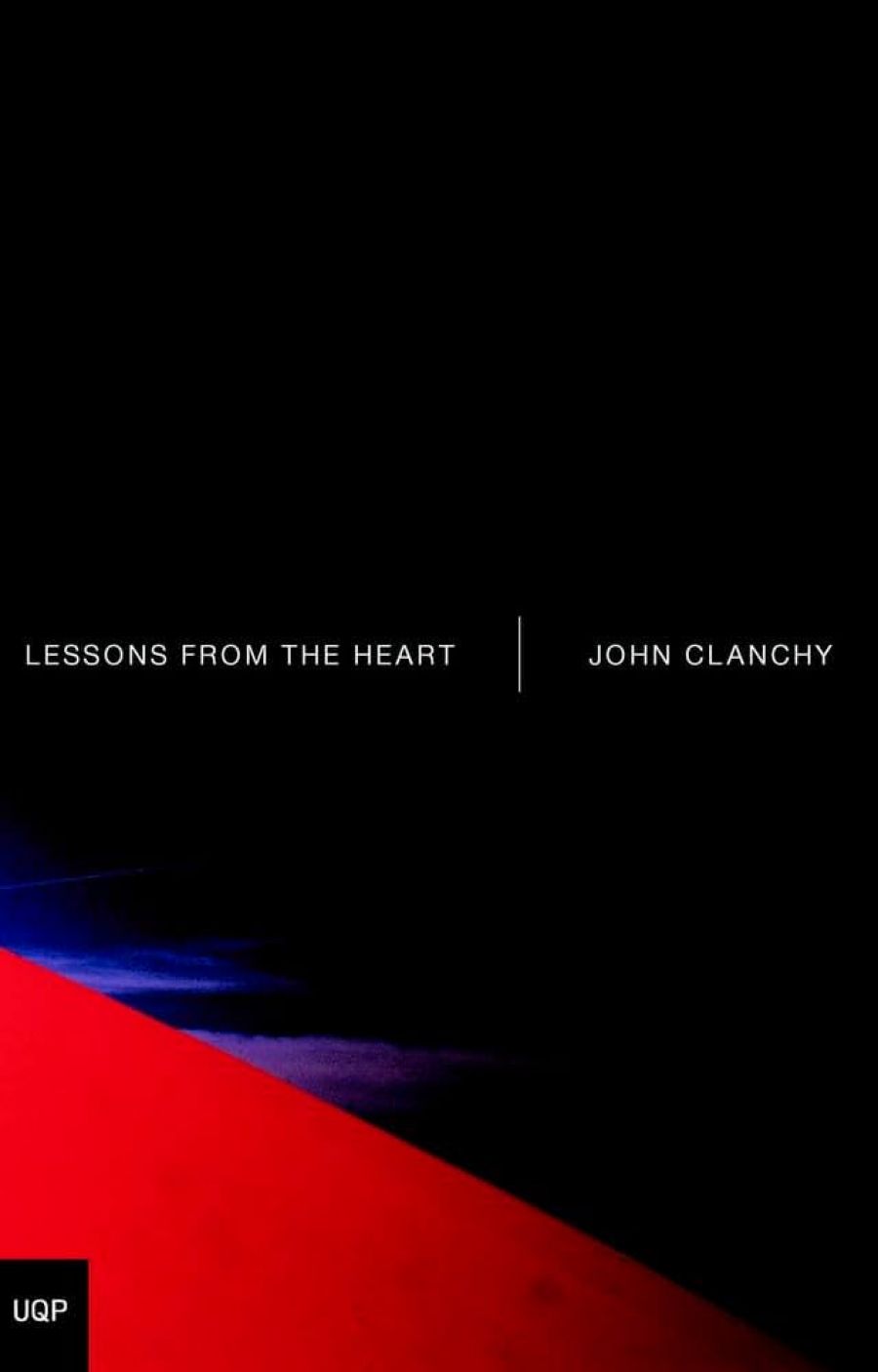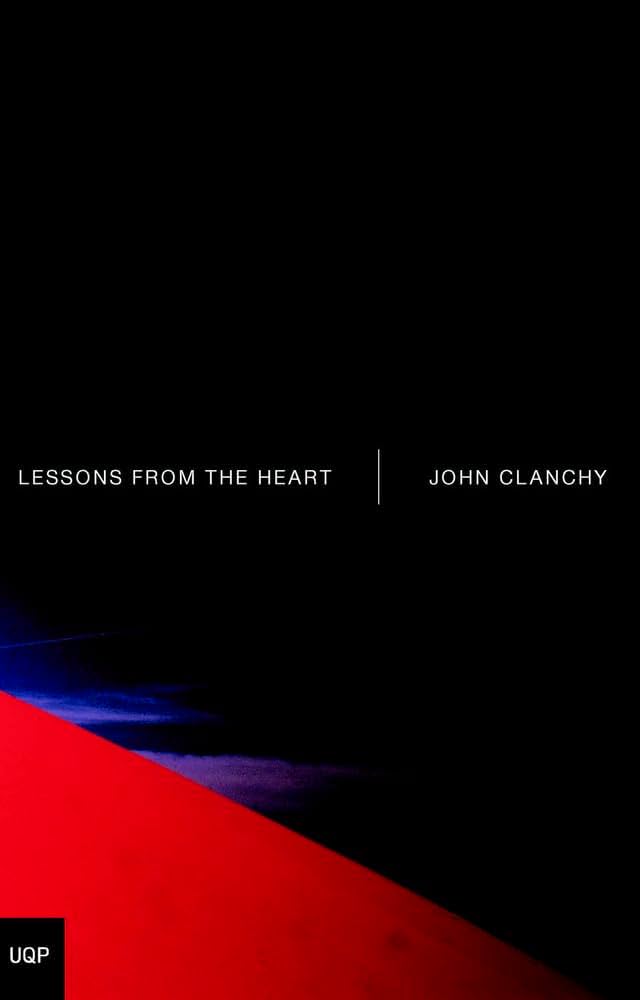
- Free Article: No
- Contents Category: Australian Fiction
- Review Article: Yes
- Article Title: A Rock and a Hard Place
- Online Only: No
- Custom Highlight Text:
John Clancy does a number of curious things in his new novel. One of them is to put Patrick White’s Voss into the hands of his heroine. Laura is in Year 12. Her teacher, Miss Temple, happens to find a copy of Voss when they are together on a school excursion to Alice Springs. Laura immediately warms to the book. She is a remarkable young woman, sensitive and resourceful. Destined to study medicine, she has literary gifts as well. People offer her jobs at places where others her age are queuing for work. One of her reasons for going on the school excursion, where she helps supervise a group of Year 7 and 8 children, is that she is recovering from the termination of her relationship with Patrick, her slightly older beau.
- Book 1 Title: Lessons from the Heart
- Book 1 Biblio: UQP, $22 pb, 331 pp
- Book 1 Cover Small (400 x 600):

- Book 1 Cover (800 x 1200):

Laura is an immensely attractive character. She is honest about her confusions and compromises. She has good things to say, which is just as well, because the book is her monologue. My problem is that I have never met such an individual. After a time, I began to wonder if I ever could. She spends a great deal of time thinking about a poem by Philip Larkin. Maybe I was jealous: I have never been able to get to the end of Voss.
Lessons from the Heart is a sequel to The Hard Word (2002). Sequels are a risk. In this case, I preferred the earlier book. Laura is younger in The Hard Word, and a bit more brattish. Her mother, Miriam, is coping with the fact that her own mother, Vera, has Alzheimer’s and has come to live with the family. Miriam tutors migrants who are learning English, women who have themselves been to the end of the tether and managed to hang on. Their teacher has much to learn from them. One of the strengths of The Hard Word is the range of voices used in telling the story: Laura’s, Miriam’s, Vera’s and that of Laura’s stepfather, Phillip. Beyond that, it includes the stories, if not the voices, of migrant women. It is also a book that benefits from the compression of the struggles it deals with within the walls of one house and, at the same time, from the sharing of them across generations. The Hard Word is a small gem. It was always going to be hard to surpass, especially since one of the more interesting characters, Vera, died at the end. Perhaps this is why Lessons from the Heart concludes when another elderly person is about to be introduced into Laura’s world. The book sets up a further sequel in which Laura will return to Greece to meet her ageing grandmother, as well as her half-sisters and her estranged father.
In Lessons from the Heart, Clanchy allows Laura to quote from Voss. The passages she lights upon are undeniably rich. They also made me thankful I was reading Clanchy. His prose has the kind of blunt energy that is often associated with work for young adults. Although his books do not appear to be marketed directly to that audience, this could be where they find their most appreciative readers.
Clanchy also has a way of raising his eyebrow at pretentiousness. On one occasion, the busload of teenagers, having left Uluru, stops outside KFC in Alice Springs. They watch an Aborigine emerge from the store and drop the litter from his meal in the street. The children want to know why he does this when their teachers have been telling them that indigenous people have such a strong relationship with the environment. The teacher tries to make it up as he goes along. He says that part of being a hunter-gatherer is to use things and discard them. The kids then want to know why hunter-gatherers are eating at KFC in the first place.
Conversations like this ring true. They offset the kind of consumer mysticism that sometimes attends the portrayal of anything Aboriginal. Clanchy avoids this trap. On one occasion, a young student meets an Aboriginal woman at Uluru. The woman immediately intuits that the girl is indigenous. She invites her to return to join in a ceremony when she is older. This would seem a bit wide-eyed to me, except for the fact that the woman is also trying to cadge a cigarette. Clanchy shows respect for his Aboriginal characters by sticking closely to his observer status. The book visits their world. It doesn’t claim to live there.
Lessons from the Heart has much to say about the role of the teacher. It shows the best and the worst of the breed. Its hero is Miss Temple, a teacher who ‘thinks all athletes have mental tinea’. But the real grist in Lessons from the Heart is a sexual relationship that develops between one of the teachers on the excursion, Mr Prescott, and Laura’s friend Toni. It is a brave thing for a male, middle-aged author to venture into the field of female teenage sexuality. Once, when Laura vividly describes her experience of orgasm, I detected a kind of prurience in the writing. For much of the book, Clanchy deals with a relationship that transgresses normal boundaries. He doesn’t glamorise it, but nor does he pour scorn. He wants to create characters rather than debate an issue.


Comments powered by CComment